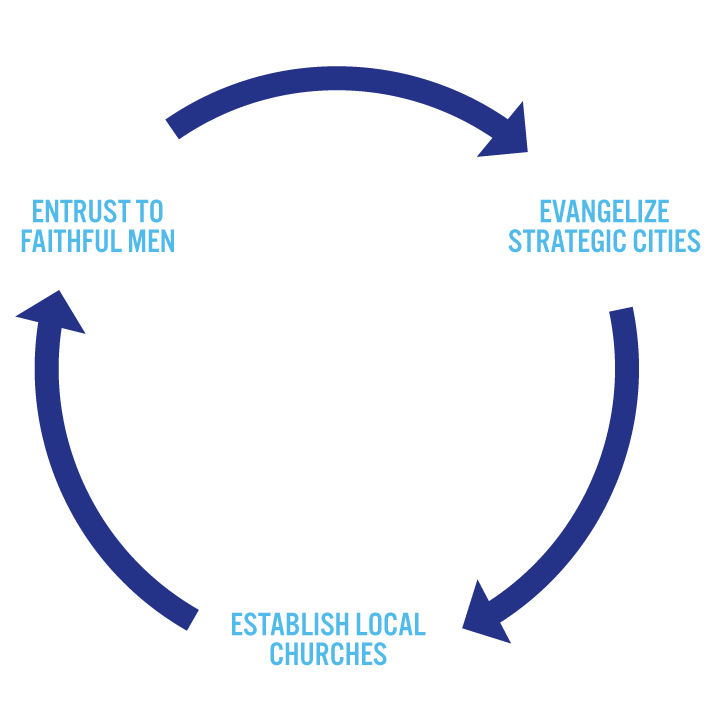We are introducing a paradigm––church-based theological education––a paradigm based on the way Christ and His Apostles developed leaders, very different from our institutional model. What do we mean by "the way of Christ and His Apostles?" It can be summarized in four concepts.
Paul began his work by taking the gospel to strategic cities, maybe better referred to as strategic areas. He preached the gospel and then gathered the believers together around Christ's teaching and quickly formed them into a church, appointing elders in every church. He then moved on to a new area, expecting the churches to permeate the surrounding areas with the gospel.
On future missionary journeys, he would send letters, key men on his team, or personally visit them, seeking to establish them more firmly in "the teaching," in order that they would become strong. An established church is not one with a pastor and a building, but rather a community of believers with strong leadership, so rooted in the gospel and "the teaching" that no one can come in and upset entire families with another teaching.

The second concept focuses on the second part of the Pauline cycle––establishing churches. It folllows a biblical theology approach, which means that we let the Bible unfold naturally and categorize itself before we impose our own categories. In this case, we cluster the early, middle, and later letters of Paul together, naturally, as they were written.
What are the letters of Paul and the other Apostles that are included in the New Testament? They are letters intended to establish the churches in the Apostles' doctrine––"the faith," "the deposit," "sound doctrine"–– all terms used in the letters for the teaching of Christ, deposited through the Apostles to the churches.

The early letters of Paul were all intended to establish the churches in the gospel. If this foundation was not laid, then they could not go on to be more mature churches. Think through these letters: Galatians, 1 and 2 Thessalonians, 1 and 2 Corinthians, and Romans.
The middle letters are all similar in terminology and emphasis. The full plan of the Church is revealed in Ephesians and Colossians. The churches are encouraged to strive together for the progress of the gospel, and this can only be done if they are one-minded around the plan of Christ, the Church. How could they be one-minded if they were not established in the gospel and were not willing to build their churches around Christ and His administration, the Church?
1 & 2 Timothy and Titus are Paul's final letters. They are all similar in style as well. Paul reviews for Timothy and Titus how to build strong families and leaders in the church and how to make each church a big household–a family of families. If the churches did not have strong leaders, no one would protect the community from false teachers coming in and upsetting whole families. And without a strong church family (community), there would be no impact in the city.
The third concept focuses on the didache. This is the Greek term in the New Testament for “the teaching.” The Early Church devoted itself to the Apostles’ teaching (Acts 2:42). In the letters, the Apostles’ teaching is called “the faith,” “the deposit,” and the “sound doctrine,” which they were to hold to. Believers and churches were considered established when they were rooted in this teaching.
A careful study of the Apostles’ letters to the churches makes it easy to identify this teaching, since the elements are repeated again and again in the letters.
The structure of Paul’s letters to the churches is fairly consistent. First he focuses on the kerygma and then the teaching, or didache.
The term used by the early Christians for the essence of the gospel message; the Greek word means proclamation.
Jesus died, was buried, and rose again, and we are saved by trusting in His work on the cross for forgiveness of sins, and we now have a new identity in Christ.
The teaching they were to be established in.
Letter by letter, again and again, they were told to put off the old man and put on Christ, to walk in the fruit of the Spirit, to have orderly households, to love and serve one another, to submit to governing authorities, and to live sober watchful lives, waiting for Christ’s return.
“The teaching” (called sound doctrine) has become a cold, abstract proposition known as theology or denominational doctrinal statements. It is built upon centuries of western controversies, which almost hide the natural process of learning doctrine in the context of family and community life.
The final piece of the philosophy is now ready to be put in place. This regards the third part of the Pauline cycle—the training of leaders. Paul refers to this as entrusting the deposit (of sound doctrine) to faithful men.
There were two spheres of leaders to whom Paul entrusted the churches.
Most people don’t know it, but Timothy went with Paul on his team when he was in his late teens and was used to take the letter to the Thessalonians and help establish them when he was about 20. But he worked on Paul’s team until he was fully commended as a master craftsman, in his late 30s. Today, in our modern western theological institutions, we give young people masters’ degrees before they have mastered anything!
This philosophy, which we refer to as “the way of Christ and His Apostles,” is characterized by tenets of a new paradigm in theological education called global church-based theological education.
